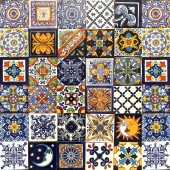Moroccan bejmat tiles - sea blue
Moroccan bejmat tiles are handmade and hand-painted. They are made of clay, which is then fired in traditional kilns. The tiles are stain-resistant.
- Thickness: 1.4 cm
- Dimensions: 15x5cm and 15x7.5cm
- The product is sold per m2
- Wall and floor tiles
- Can be laid in many ways, such as brick or herringbone
- Glazed tiles
- Colours may vary slightly
Bejmat tiles are traditional Moroccan tiles with a history dating back centuries. They are particularly popular in Islamic architecture and constitute an important element of Moroccan ceramic craftsmanship. Bejmat tiles come from the same tradition as the world-famous zellige tiles, but differ in shape and installation technique. Initially used in palaces, mosques, and the homes of wealthy merchants, today they are widely used in modern interior design. Tiles are most often available in 15x5cm and 15x7.5cm sizes and have a matte or slightly glossy surface. Thanks to their durability and aesthetics, they are suitable for a variety of spaces: kitchens, bathrooms, hallways, and living rooms. The tiles also look phenomenal in public spaces such as restaurants, hotels, and boutiques.
Zellige tiles can be installed in a variety of ways:
- Straight (parallel) arrangement – tiles laid parallel to the walls, one next to the other.
- Brick layout (1/2 offset) – each subsequent line is offset by half the length of the tile.
- Brick layout (1/3 offset) – each line is offset by 1/3 the length of the tile.
- Vertical layout – tiles arranged vertically instead of horizontally.
- Herringbone layout – arranged at a 45° or 90° angle, creating a herringbone effect.
- Basket weave layout – tiles arranged in groups of two or four, resembling a basket weave.



















